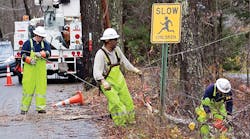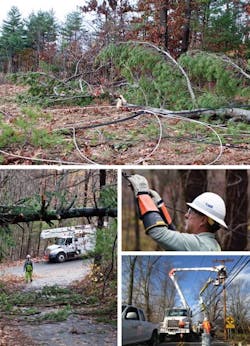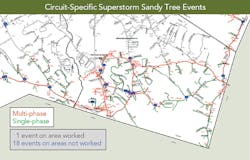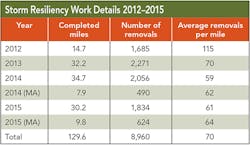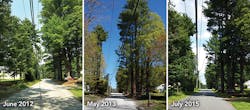It is standard practice for utilities to employ vegetation management programs to minimize outages during normal days and minor weather events. These programs — which involve pruning vegetation away from overhead electric utility lines and assessing adjacent trees to remove diseased, weak or dead limbs and trees — have a well-established value within the industry.
While these programs have proven effective in maintaining reliability in typical weather conditions, a recent increase in storm frequency and intensity in 2010 and 2011 in the northeastern U.S. has tested typical vegetation management programs to their fullest and resulted in public demand for a more resilient electric system.
To combat this changing, more intense weather pattern, Unitil has put in place a more proactive program to reduce the volume and damaging effect of outages from tree and limb failures during major storms. Early results indicate the program is providing a measurable improvement to reliability, even in the wake of severe weather events.
Piloting a Storm Resiliency Program
In 2012, Unitil launched its new vegetation storm resiliency program (SRP) as a pilot. The program was tailored to serve as a companion to the utility’s existing, more traditional core vegetation management program, which consists of cyclical pruning and hazard tree removal. The crux of the SRP is as follows:
• The program is performed on handpicked circuits only, and then only on critical portions of those circuits — typically the three-phase from a substation out to a desired protected device — with the goal of protecting as many customers served on the line as possible.
• Unitil arborists and trained inspectors complete an intensive tree risk assessment of all trees that are tall enough to fall and impact the electric lines, with the goal of removing trees that pose a risk of failure because of a defect, disease or species-specific failure trait. For trees that do not pose a failure threat, the goal is to have ground-to-sky clearance or to remove all limbs overhanging the conductors.
• Local first responders are consulted to target areas that will improve lifeline, life safety and communications resources. Where possible, these crucial services (such as police, fire, schools, shelters, hospitals, gas stations and food) are included in the SRP’s critical portion scheduling.
The initial kickoff of SRP began with an intensive assessment in the Atkinson/Plaistow region of New Hampshire in 2012. This started with reviewing and mitigating a manageable number of miles to gauge customer acceptance, effectiveness and cost. Unitil needed to test two theories:
• Customers would embrace the work and allow pruning and removal of privately owned trees for the greater public good.
• During a storm event, the work would provide critical lifeline, life safety and communications resources available to municipalities while reducing the damage sustained to the system, thus reducing restoration time and necessary crews.
Putting Storm Resiliency to the Test
As fate would have it, Unitil’s SRP was tested in the first few months of the pilot’s tree-removal phase. Tropical Storm Sandy, a major subtropical weather event also known as Superstorm Sandy, blew through in October 2012, causing substantial damage to a large portion of the Eastern seaboard. At the time of the storm, one circuit of storm resiliency work was nearly complete and work had just begun on two other circuits.
While the region did not receive as direct a hit as regions to the south, the strength of the storm still caused approximately 440,000 customers to lose power in New Hampshire and Massachusetts. Interestingly, the circuit in which SRP work was almost complete did not suffer a circuit lockout during the storm. Only one tree failure occurred on this circuit’s SRP area, and Unitil was already in negotiations with a hesitant customer about removing the tree when the storm came through.
On the other circuit that had been inspected already, two failures occurred on the main line where trees were marked for removal but had not yet been removed. These trees, documented for removal as part of the pilot, caused a lockout on the circuit.
Statistics at that time proved the program was having an impact. Unitil used the almost complete circuit to estimate the number of events that potentially had been avoided as a result of the SRP work. Looking at the data, only one event occurred (because of customer refusal) in a 5.5-mile area where resiliency work had been performed, compared to the 18 events experienced on the other 20.5 miles of line.
Based on the available data, it was determined the portion of circuitry without storm resiliency work had an event every 0.7 miles. Therefore, it was logical to estimate an additional 3.85 events would have occurred within the SRP area had Unitil not done the storm resiliency work. In other words, the utility avoided 3.85 events on mainline circuitry because of its SRP work.
Unitil took those early results to the state of New Hampshire and asked to move the program from pilot to permanent status and then later proposed it to Massachusetts as part of a rate case proceeding. New Hampshire ultimately approved a second-year pilot and then made the program permanent. In early 2014, Massachusetts approved the SRP as well.
The program’s second test came in the fall of 2014, when a storm blanketed New England with several inches of heavy, wet snow the night before Thanksgiving. Out of 30,000 Unitil customers served in the Concord, New Hampshire, area, approximately 23,000 woke up without power on one of the busiest holidays of the year. However, three circuits in the Concord area had undergone storm resiliency work in 2013, and two of them suffered no outages in the SRP-worked area. A third area suffered an outage caused again by a tree on private property where a customer refused removal.
While some outages still occurred, there was a clear correlation between circuits where SRP work had occurred and a reduction in the number of customers interrupted per overhead mile and the number of incidents, when compared to surrounding circuits where storm resiliency work had not yet occurred.
Gaining Customer Acceptance
Education has been an invaluable component to increasing customer acceptance of Unitil’s SRP. The utility puts an enormous amount of effort into educating its customers on the impact of diseased and hazardous trees on power lines; however, at times, the utility still gets some pushback. For example, several citizens in one town in New Hampshire questioned why several trees they felt added to the character of their quaint downtown area were tagged for removal. As a result of careful identification and record keeping as each tree was inspected, members of the arborist team were able to meet with those concerned and discuss the health issues tree by tree.
In another town, a neighbor — not a landowner — objected to the removal of a tree because he would lose an important element of his view. By directly addressing his concerns in person, Unitil was able to gain the approval of the neighbor and also explain the current limitations of the town’s tree care budget. The resident ended up engaging with the town directly to take proactive tree care steps for his community.
Unitil’s goal is not to decimate an area; instead, it takes care to minimize the impact when removing trees. During the removal process, arborists are able to leave surrounding vegetation undisturbed in some areas by using a crane to remove trees. Wood is often left for the homeowner’s use, and affected residents are encouraged to participate in the utility’s tree-replacement program provided in partnership with the Arbor Day Foundation. The program enables customers to choose trees that provide energy savings around their homes; trees removed near wires can be replaced, even in the same area with the choice of low-growing species.
At the end of 2014, Unitil’s education efforts were paying off. Among the more than 2,000 trees tagged for removal in 2014, only 11 were refused by homeowners. Even then, work planners were allowed to schedule some pruning work on these remaining trees to lessen their overall threat.
Training to Meet Expectations
Training has proven to be the key ingredient in ensuring line clearance vendors — two tree-removal companies and a contract forester — are performing up to expectations. Forestry field supervisors typically spend at least two full days up front with the contract forester assessing and marking trees together as well as learning the program goals. After a full week of work planning, the work is reviewed and the level of tree-removal intensity is adjusted as needed.
A tree risk assessment training guide was created that contains a matrix as well as other tools to help identify which trees to remove based on type and severity of defect, addition of modifiers and likelihood of failure. Although modeled after the ANSI hazard tree assessment standards and fitting within the International Society of Arboriculture’s Tree Risk Assessment Qualification program, a fair amount of subjectivity still exists within the program. The tree risk assessment protocol that was developed helps to remove as much subjectivity as possible.
Weighing the Cost of the Program
SRP work does not come cheap. Because educating and gaining approval from landowners is an intensive process, and because numerous large trees are removed with specialized equipment and often unwanted wood is hauled away, it would be hard to justify the program if the benefits were insignificant.
One program justification is the avoidance of costs associated with the direct damage of storms themselves. This cost avoidance is at the utility level. This is as simple as requiring fewer crews for a shorter time, which keeps the cost of a storm lower.
A second program justification is the regulatory environments in both New Hampshire and Massachusetts show a clear preference for proactive measures in making the system more resilient where it is feasible to do so. It is clear some amount of upfront cost is acceptable if results are delivered.
A third program justification is the customer base has shown a clear preference toward proactive work as well as a desire to avoid costs some associate with extended outages, such as the cost to retailers for closed doors or the cost to the individuals for lost work time, spoiled food or costly alternative heat sources. Combined, Unitil feels the price of the SRP is more than justified when the benefits from these external factors are considered.
Results by the Numbers
Unitil’s success thus far is encouraging for the future of its SRP, and plans are in place to continue the program, measure its results and fine-tune the program along the way. By the end of 2015, Unitil had completed storm resiliency work on 8.2% of its system, covering 129.6 miles and performing 8,960 removals on the covered area.
The results have been profound. In 2010, two years before the SRP began, Unitil had 613 tree-related incidents, leading to 101,760 customers interrupted. In 2015, after multiple years of SRP, Unitil had only 315 tree-related incidents with 46,860 customers interrupted.
When looking at the difference in the circuits that underwent SRP in 2012 versus the circuits that did not, 64% fewer customers were interrupted per overhead mile on SRP circuits for the following year versus the number of customers interrupted on other circuits. The numbers indicate Unitil’s storm resiliency and core vegetation management programs are not only protecting the system in major weather events, but they are also beginning to maximize resiliency and minimize outages throughout the rest of the year.
Going forward, Unitil plans to narrow its review of the program results to look more closely at the sections of SRP circuit worked and also to collect more tree failure data in storm events so a more informed appraisal of the SRP results can occur. System data also will be used to identify the types of trees that are failing and to look for trends. At the 10-year mark, Unitil plans to reassess its SRP to see if the program continues to measure up to the utility’s ultimate goal of preventing customer outages in the wake of more powerful and frequent storms. To put it mildly, the initial data has been extremely promising.
Sara Sankowich is the system arborist at Unitil Service Corp. Previously, Sankowich managed vegetation management strategy at National Grid and worked as an arborist for Orange & Rockland Utilities. She has a BS degree in forest and natural resource management from the State University of New York. She is an International Society of Arboriculture certified arborist, serves on the Utility Arborist Association research committee and is the New Hampshire state representative on the board of directors for the New England chapter of the ISA.
